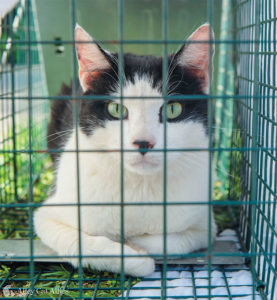Getting Started with Trap-Neuter-Return (TNR)

TNR is the humane, effective approach to outdoor cat populations.
People all over the country, from all walks of life, care for outdoor cats every day. Like them, you’ve discovered cats in your community, and you want to help them. The millions of cats who make their homes outdoors are called community cats. You may also hear them called feral cats, though not all unowned, outdoor cats are feral.
Community cats are domestic cats–the same species as pet cats, Felis catus. The difference is that community cats are unowned and generally not socialized to people, so they cannot be adopted. But community cats are not homeless. They have a home: the outdoors.
The best way you can help community cats is through Trap-Neuter-Return (TNR). TNR ensures no new kittens are born, stabilizes cat populations, provides vaccines, and improves cats’ lives. It also stops the behaviors and stresses associated with mating such as yowling, spraying, and fighting.
What Is Trap-Neuter-Return?
Trap-Neuter-Return is the only humane and effective approach to community cat populations. Here are the basic steps to this lifesaving process:
- Trap: Humanely trap all the cats in a colony. A colony is a group of cats living outdoors together.
- Neuter (or spay): Take the cats in their traps to a veterinarian or clinic to be neutered, vaccinated, and eartipped (the universal symbol of a neutered and vaccinated cat. Learn more at alleycat.org/Eartip).
- Return: After the cats recover, return them to their outdoor home where they were trapped.
TNR is Mainstream
TNR is practiced across the United States and all over the world. It’s considered best practice and is good public policy. TNR is supported by all credible animal protection organizations including the American Society for the Prevention of Cruelty to Animals (ASPCA), the Humane Society of the United States (HSUS), the American Animal Hospital Association (AAHA), the National Animal Care and Control Association (NACA), as well as hundreds of TNR groups nationwide, and the countless individuals who carry out grassroots TNR programs.
Helping Cats 101: Don’t Bring Cats to the Shelter
Cats don’t belong in shelters. And these days, most shelters agree.
If you’re like a lot of people, your first instinct when you find a cat in need is to call animal control or perhaps rush the cat to your local animal shelter. , Depending on your local policies, doing either of these things may put the cat’s life in danger. In some areas, when cats are brought into shelters, it is a death sentence. Because community cats are generally not socialized to people, they are unadoptable–which historically has meant that most of them were killed in shelters. Nationally, positive outcomes for cats brought to shelters, even friendly cats, though improving, remain abysmally low.
The good news is that an increasing number of animal shelters and animal control agencies are embracing humane policies for cats. Many are supporting community TNR efforts or creating TNR programs of their own, sometimes referred to as Shelter-Neuter-Return (SNR), Return to Field (RTF) or Feral Freedom. That’s why it is important to know YOUR local shelter’s policies for community cats. Learn more at alleycat.org/AnimalShelters.
How to Help Cats Effectively and Humanely
You’ve come to the right place. Alley Cat Allies is the leader of the global movement to protect and improve cats’ lives. Through our cutting-edge programs and fearless advocacy, we champion the humane treatment of all cats and kittens. We work toward a world where every cat is valued and protected and every community and shelter has policies and programs to defend them.
Since 1990, Alley Cat Allies has helped hundreds of thousands of individuals, shelters, and organizations worldwide improve the lives of cats by providing guidance on how to implement TNR and by educating communities about the benefits of TNR. Our information will give you the knowledge and confidence needed to join the thousands of compassionate people around the world working to help community cats!
Our Cat Care – Trap-Neuter-Return information is grouped into these sections:
We recommend that you read this entire guide and find answers to your questions before you begin trapping.
Alley Cat Allies’ Feral Friends Network®
A member of Alley Cat Allies’ Feral Friends Network may be able to aid or guide you in helping community cats. You may even be able to participate in TNR with a Feral Friends Network Member to see TNR in practice before you begin trapping on your own. Members have different areas of expertise, such as advising on TNR, loaning out humane traps, or providing veterinary services like spay and neuter for community cats.
Request a list of Feral Friends Network members in your area at alleycat.org/FindFeralFriends.
More Information
- How You Can Help Community Cats: A Step-by-Step Guide to Trap-Neuter Return
- Video: All About Trap-Neuter-Return
- Video: Step-by-Step Guide: Trap-Neuter-Return
- Webinar: Helping Cats in Your Community
- Learn more about our work: Trap-Neuter-Return
- Why Trap-Neuter-Return for Community Cats? The Case for TNR

